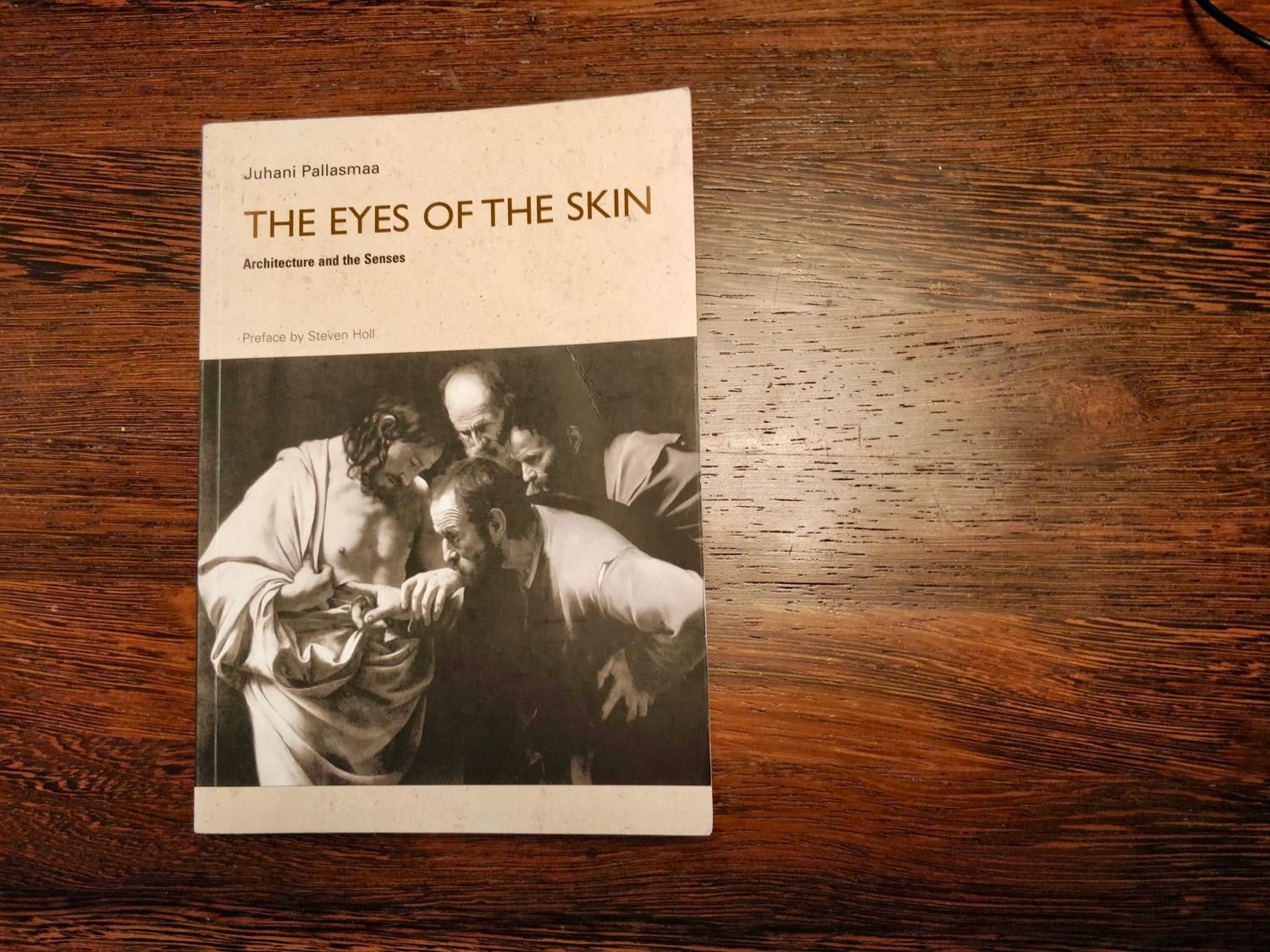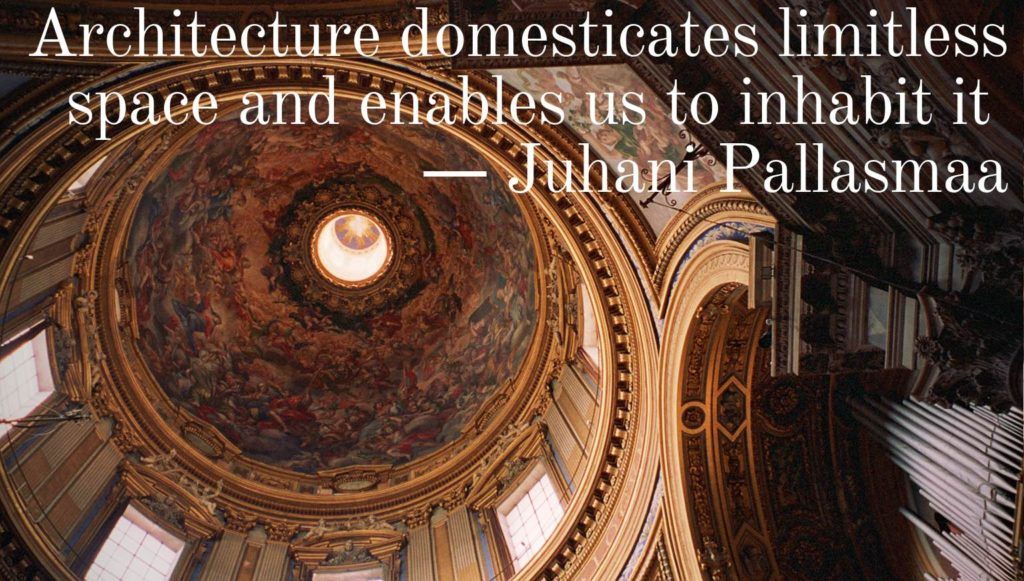The Eyes of The Skin Review

The Eyes of the Skin: Architecture and the Senses by Juhani Pallasmaa
Introduction
This book is a short but beautifully crafted argument for an Architecture based less on the sense of sight and more on the other senses, and about how touch is the core sense from which the others flow. It argues we have gone too far in holding sight above those other senses, particularly in Architecture and that there is a better, deeper way to understand and shape the spaces we design.
Book History
Pallasmaa wrote the argument out as an essay and lecture, then turned it into a book first published in 1996 which quickly became a classic of Architectural Theory. Amazon has it at 130 pages long but my edition is only 80 pages! Either way it’s a short and fairly quick read provided you are familiar with the references Pallasmaa makes. If you don’t you might find it hard work to digest.
Basic Premise
The skin is the oldest and most sensitive of our organs, and touch is the sense that became differentiated into all the other senses. The understanding of our external environment is much more co-dependant on all the senses. But vision is the sense that is increasingly dominating in Architecture. Pallasmaa sets out the case for the tactile senses in the experience and understanding of the world and in the design of buildings and cities. That the pre-conscious perceptual realm, that of peripheral vision contains the quality of architectural reality much more than a focused image. The quote below joins up these associated ideas and expresses them beautifully.
‘I confront the city with my body; my legs measure the length of the arcade and the width of the square; my gaze unconsciously projects my body onto the facade of the cathedral, where it roams over the mouldings and contours, sensing the size of recesses and projections; my body weight meets the mass of the cathedral door, and my hand grasps the door pull as I enter the dark void behind. I experience myself in the city, and the city exists through my embodied experience. The city and my body supplement and define each other. I dwell in the city and the city dwells in me.’
- Juhani Pallasmaa
The Privileging of Sight
Pallasmaa outlines firstly how and why the sight became privileged over the other senses over time. The eyes and eyesight have traditionally been felt to influence the construct of philosophy. To ‘see’ something clearly is to understand it.
‘The eyes are the organic prototype of philosophy. Their enigma is that they not only can see but are also able to see themselves seeing. This gives them a prominence among the body’s cognitive organs. A good art of philosophical thinking is actually only eye reflex, eye diabetic, seeing-oneself-see’
- Peter Sloterdijk as quoted by Juhani Pallasmaa.
Not only that but the idea of perspective of a story or sequence with a plot or horizon tends to set understanding of the world in a visual way. Architecture is our primary sense in relating us with space and time, and giving these dimensions a human measure.
‘Architecture is the masterly, correct and magnificent play of masses brought together in light’
- Le Corbusier
Pallasmaa talks about the unending rainfall of images in the modern world and that was at a time before the internet became the medium of modern connected culture that it is today. If it was true in 1996 than it is even more so today. So this narcissistic eye views architecture solely as a means of self expression, and an intellectual game of surfaces only.

Oral vs Visual Space
‘the shift from oral to written speech was essentially a shift from sound to visual space’
-Walter J Ong in Orality & Literacy
Written speech moves us towards visual space. Not found in the book but again I can think of some of good examples here which illustrate the point. The Finnish Kalevala is a huge poem that tells the epic story of Finnish culture from before Finnish was written down as a language. Only after this was the Kalevala poem or song written down, it actually had to be saved for posterity. Likewise the Aboriginal songlines which are stories that literally mean Australia was mapped aurally long before it was mapped or even represented visually.
This increasing visual bias has never been more prevalent than in the last 30 years and though it’s not in crisis a change has occurred recently for the worse in Architecture such that the image is almost exclusively the frame through which we understand Architecture. Also that the methods of production of Architecture, modern capitalism, have reinforced visual primacy.
The Body In The Centre
But naturally we sense space through our bodies primarily. Everything we sense is measured out in reference to ourselves and our own bodies and everything in turn is shaped based on these spatial understandings. We should also talk about sensory systems, and not senses separated from each other. The delineation of these senses rigidly tends to obscures the fact that they build understanding when used together.
Babies Feel Objects to Understand Them
Something again not covered in the book but worthy as an observation at this point is that children use touch and taste at least as early as vision in understanding the world around them. Children younger than seven months can grab objects but they can’t explore them with their hands yet and instead of looking at the things they pick up they put them straight into their mouths. A baby’s mouth has more nerve endings than any other part of the body so to really find out about that object a baby just puts it in their mouth.
Slow Down
The speed of modern life and procession of contextless images has collapsed time. The other senses like sound especially restore a sense of time to Architecture. For Pallasmaa sound incorporates, it is omni-directional and can structure and articulate experience. Also smell brings in memory more strongly than the other senses. For Pallasmaa the most consistent memory of a space is often it’s smell. These added senses prioritise the interior qualities of a space.
’Architecture of the exterior seems to have interested architects of the avant-garde at the expense of architecture of the interior. As if a house were to be conceived for the pleasure of the eye rather than for the wellbeing of the inhabitants.
- Eilen Gray
Architecture qualities then should not be though of as immaterial timeless things but instead think of them as space verbs so instead of space, use spacing. Instead of time, use timing.
Summary
Perhaps if there is something I could criticise the book over is that Pallasmaa give Mies van Der Rohe and Corbusier a little bit of a free pass, maybe even most of the early modernists? By stating that it’s the last 30 years in which this change has occurred and not, for example, mentioning the rise of photography and printed images and their use in Architecture he is excluding his favorite Architects from the implied criticism he levels at newer buildings. But the image is primarily how the international style spread after all. Think Mies’s Friedrichstrasse Skyscraper Project of 1921 which was just a sketch, but one which circled the globe and was a huge influence internationally.
‘ All experience implies the acts of recollecting, remembering and comparing.’
- Juhani Pallasmaa
Pallasmaa ends with a call for Architects to refocus of the human condition as their Architectural cornerstone. I have to say I wholeheartedly agree.
Recommended Reading
I see this book on many suggested student reading lists. It should be on all of them, but not in the first year of study. I think that it should be read after the student or reader has a basic understanding of the key figures and a basic outline of the beginnings of modern Architecture in the 20th Century. Why so? Well this is a very theoretical book and it builds its case on other Architectural Theories, books and quotes. It’s a re-examination of some of those things and its best done when the reader has some familiarity with those ideas.
You may also want to look at my review of The Thinking Hand also by Juhani Pallasmaa which is in many ways a continuation of the ideas laid out in this book.